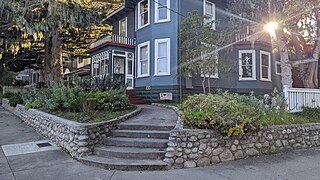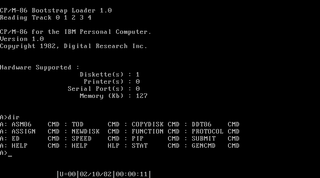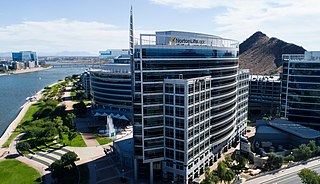
Gary Arlen Kildall was an American computer scientist and microcomputer entrepreneur. During the 1970s, Kildall created the CP/M operating system among other operating systems and programming tools, and subsequently founded Digital Research, Inc. to market and sell his software products. He is considered a pioneer of the personal computer revolution.

CP/M, originally standing for Control Program/Monitor and later Control Program for Microcomputers, is a mass-market operating system created in 1974 for Intel 8080/85-based microcomputers by Gary Kildall of Digital Research, Inc. CP/M is a disk operating system and its purpose is to organize files on a magnetic storage medium, and to load and run programs stored on a disk. Initially confined to single-tasking on 8-bit processors and no more than 64 kilobytes of memory, later versions of CP/M added multi-user variations and were migrated to 16-bit processors.

Digital Research, Inc. was a privately held American software company created by Gary Kildall to market and develop his CP/M operating system and related 8-bit, 16-bit and 32-bit systems like MP/M, Concurrent DOS, FlexOS, Multiuser DOS, DOS Plus, DR DOS and GEM. It was the first large software company in the microcomputer world. Digital Research was originally based in Pacific Grove, California, later in Monterey, California.

Dynamic Debugging Technique (DDT) is a series of debugger programs originally developed for Digital Equipment Corporation (DEC) hardware, initially known as DEC Debugging Tape because it was distributed on paper tape. The name is a pun on the insecticide DDT. The first version of DDT was developed at MIT for the PDP-1 computer in 1961, but newer versions on newer platforms continued to use the same name. After being ported to other vendor's platforms and changing media, the name was changed to the less DEC-centric version. Early versions of Digital Research's CP/M and CP/M-86 kept the DEC name DDT for their debugger, however, now meaning Dynamic Debugging Tool. The CP/M DDT was later superseded by the Symbolic Instruction Debugger in DR DOS and GEM.

Gen Digital Inc. is a multinational software company co-headquartered in Tempe, Arizona and Prague, Czech Republic. The company provides cybersecurity software and services. Gen is a Fortune 500 company and a member of the S&P 500 stock-market index. The company also has development centers in Pune, Chennai and Bangalore. Its portfolio includes Norton, Avast, LifeLock, Avira, AVG, ReputationDefender, and CCleaner.

Alan Cooper is an American software designer and programmer. Widely recognized as the "Father of Visual Basic", Cooper is also known for his books About Face: The Essentials of Interaction Design and The Inmates Are Running the Asylum: Why High-Tech Products Drive Us Crazy and How to Restore the Sanity. As founder of Cooper, a leading interaction design consultancy, he created the Goal-Directed design methodology and pioneered the use of personas as practical interaction design tools to create high-tech products. On April 28, 2017, Alan was inducted into the Computer History Museum's Hall of Fellows "for his invention of the visual development environment in Visual BASIC, and for his pioneering work in establishing the field of interaction design and its fundamental tools."
PL/M, an acronym for Programming Language for Microcomputers, is a high-level language conceived and developed by Gary Kildall in 1973 for Hank Smith at Intel for the Intel 8008. It was later expanded for the newer Intel 8080.

The IMSAI 8080 is an early microcomputer released in late 1975, based on the Intel 8080 and S-100 bus. It is a clone of its main competitor, the earlier MITS Altair 8800. The IMSAI is largely regarded as the first "clone" microcomputer. The IMSAI machine runs a highly modified version of the CP/M operating system called IMDOS. It was developed, manufactured and sold by IMS Associates, Inc.. In total, between 17,000 and 20,000 units were produced from 1975 to 1978.
Data-flow analysis is a technique for gathering information about the possible set of values calculated at various points in a computer program. A program's control-flow graph (CFG) is used to determine those parts of a program to which a particular value assigned to a variable might propagate. The information gathered is often used by compilers when optimizing a program. A canonical example of a data-flow analysis is reaching definitions.
Digital Systems Inc., was an American accounting service and technology development company active between 1966 and 1979. It was founded by John Q. Torode in Seattle, Washington. The company was reorganized into the microcomputer design and development company Digital Microsystems, Inc. (DMS), Oakland, USA, founded in 1979. In 1984, it was sold to the new UK operation Digital Microsystems Ltd. (DML) and finally ended its US operations in 1986. Without Torode, Digital Microsystems Ltd.'s product HiNet was sold to Apricot Computers Plc in 1987. In 1986, Torode founded a new company, IC Designs, Inc., based partly on Theodore "Ted" H. Kehl's VLSI technology at the University of Washington (UW), which was bought by Cypress Semiconductor Corp. in 1993.
Relocation is the process of assigning load addresses for position-dependent code and data of a program and adjusting the code and data to reflect the assigned addresses. Prior to the advent of multiprocess systems, and still in many embedded systems, the addresses for objects are absolute starting at a known location, often zero. Since multiprocessing systems dynamically link and switch between programs it became necessary to be able to relocate objects using position-independent code. A linker usually performs relocation in conjunction with symbol resolution, the process of searching files and libraries to replace symbolic references or names of libraries with actual usable addresses in memory before running a program.
Intel hexadecimal object file format, Intel hex format or Intellec Hex is a file format that conveys binary information in ASCII text form, making it possible to store on non-binary media such as paper tape, punch cards, etc., to display on text terminals or be printed on line-oriented printers. The format is commonly used for programming microcontrollers, EPROMs, and other types of programmable logic devices and hardware emulators. In a typical application, a compiler or assembler converts a program's source code to machine code and outputs it into a object or executable file in hexadecimal format. In some applications, the Intel hex format is also used as a container format holding packets of stream data. Common file extensions used for the resulting files are .HEX or .H86. The HEX file is then read by a programmer to write the machine code into a PROM or is transferred to the target system for loading and execution. There are various tools to convert files between hexadecimal and binary format, and vice versa.
A source-to-source translator, source-to-source compiler, transcompiler, or transpiler is a type of translator that takes the source code of a program written in a programming language as its input and produces an equivalent source code in the same or a different programming language. A source-to-source translator converts between programming languages that operate at approximately the same level of abstraction, while a traditional compiler translates from a higher level programming language to a lower level programming language. For example, a source-to-source translator may perform a translation of a program from Python to JavaScript, while a traditional compiler translates from a language like C to assembly or Java to bytecode. An automatic parallelizing compiler will frequently take in a high level language program as an input and then transform the code and annotate it with parallel code annotations or language constructs.
IMDOS was a modified version of the CP/M operating system for Intel 8080 processors, used by IMS Associates, Inc. (IMS) for their IMSAI 8080 personal computer. Since MITS would not license their operating system to other manufacturers, IMS approached Gary Kildall and paid a fixed fee of $25,000 for a non-exclusive CP/M license.

CBASIC is a compiled version of the BASIC programming language written for the CP/M operating system by Gordon Eubanks in 1976–1977. It is an enhanced version of BASIC-E.
A binary recompiler is a compiler that takes executable binary files as input, analyzes their structure, applies transformations and optimizations, and outputs new optimized executable binaries.
ISIS, short for Intel System Implementation Supervisor, was an operating system for early Intel microprocessors like the 8080. It was originally developed by Ken Burgett and Jim Stein under the management of Steve Hanna and Terry Opdendyk for the Intel Microprocessor Development System with two 8" floppy drives, starting in 1975, and later adopted as ISIS-II as the operating system for the PL/M compiler, assembler, link editor, and In-Circuit Emulator. The ISIS operating system was developed on an early prototype of the MDS 800 computer, the same type of hardware that Gary Kildall used to develop CP/M.

Thomas Alan Rolander is an American entrepreneur, engineer, and developer of the multitasking multiuser operating system MP/M created for microcomputers in 1979 while working as one of the first employees of Digital Research with Gary Kildall, the "father" of CP/M. CP/M and MP/M laid the groundwork to later Digital Research operating system families such as Concurrent CP/M, Concurrent DOS and Multiuser DOS. He also developed CP/NET.
Dorothy McEwen Kildall, often known as Dorothy McEwen, (1943–2005) was an American microcomputer industry pioneer. In 1974, she co-founded Digital Research, the company that developed the first computer language, the first compiler and the first mainstream operating system for microcomputers.
Kathryn Betty Strutynski was a mathematician and computer scientist, and attended University at Brigham Young University and the Naval Postgraduate School. Besides jobs at Pan Am Airways and Bechtel Corporation, she worked at Digital Research, where she contributed to the development of CP/M, the first mainstream operating system for microcomputers.








